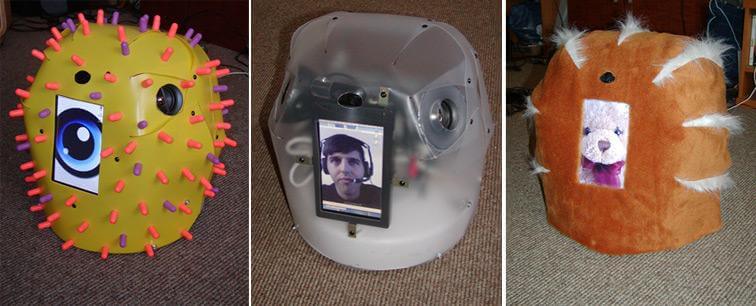In the list of awesome things to do with your free time, “build a robot” has always been right up there with “make everyone love me” and “master time and space”. Now thanks to Sparky Jr, you can accomplish all three. Sparky Jr. is an open source robot that you can build in your home. It was designed by do-it-yourself guru Marquee Cornblatt. Besides looking cool, Sparky allows you to sit at a control computer and use a webcam to communicate via monitor and speakers on the bot, giving you a telepresence wherever the robot roams. Follow Cornblatt’s detailed instructions and you’ll soon have a machine that lets you be anywhere, anytime, and endear yourself to friends and strangers. Of course, accomplishing your awesome list comes with a price tag of $1300+ and many hours of hard work, but it might just be worth it. Check out the videos after the break to learn how to build a Sparky Jr. of your very own.

Of course, Sparky Jr isn’t the first telepresence robot we’ve seen. Anybots is an amazing ROV (remotely operated vehicle) and Rovio is a fairly cheap retail device that you can use anywhere via the internet. What makes Sparky Jr. different from its competitors is that it’s completely open source and customizable. Cornblatt’s website guides you to the hardware you need, and provides the software free of charge, but it’s up to you to do all the construction. Any improvements you may make (in hardware or software) can then be shared with Cornblatt and he’ll place them on the site. This allows Sparky Jr. to evolve over time. Community directed improvements are at the core of open source technologies, and may prove to be a defining paradigm in molecular biology (via OpenWetWare), robotics (remember Willow Garage), general knowledge (sites like Wikipedia), and computer programming (Linux, and others).
Like any down and dirty DIY project, Sparky Jr seems like a bit of a Frankenstein’s monster. The computer core is a Mac Mini (~$700) which has plenty of processing power, operating software and WiFi hardware to get things going. An iRobot Create base (~$130) acts as the basic movement platform. There’s a VGA car monitor ($250), some audio equipment and miscellaneous hardware to round out the bot. Calculating the costs of the devices listed on the hardware page, I came up with a total of around $1300 in purchased parts in order to build Sparky. Cornblatt does offer to assemble the bot on your behalf, but you can rest assured that the price will be considerably higher.
Not that Cornblatt isn’t pulling his weight here. Besides giving you some great step by step instructions, he and John Celenza (from the video) provide you with all the special interfacing software you need for Sparky Jr. The actual connectivity over the internet is handled through Skype, which is also free to download. Since it is open source, all of the Sparky code is available for perusing via Google code.
Still, no amount of help from Cornblatt will make Sparky Jr anything but a major DIY project. Expect to spend many hours in assembly and construction. Looking through the videos, I think anyone could make a telepresence robot, but few will have the drive to want to do so. This is not a casual endeavor and so far few have attempted it. Of course, that just means you’ll be that much cooler if you try.
Many more may want to make the attempt. Teleconferencing and telepresence are growing trends in the market, with millions in business travel being shunted into high tech video conference rooms. Future telepresence robots may include haptics to give operators the sense of actually being in the remote location. Gas prices keep climbing, but robots are getting cheaper. We may soon see a day when saying hello to far away friends involves cute little droids you make at home. It could take some getting used to, but check out this video of the original Sparky from 1998. Even a decade ago, people seem to react well to seeing their friend’s face on a mechanical frame. The future is already here.
Photo and video credit: Marquee Cornblatt


